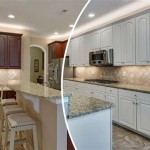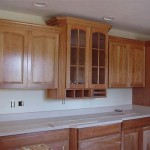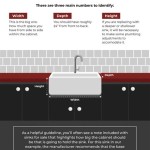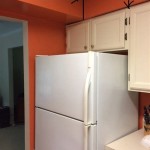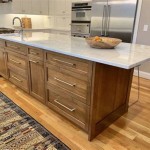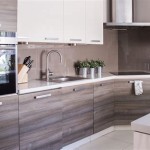The Best Paint For Kitchen Cabinets: A Comprehensive Guide
Refacing or replacing kitchen cabinets can be a costly endeavor. Often, a fresh coat of paint is all that's needed to revitalize the heart of the home. However, not all paints are created equal when it comes to kitchen cabinets. The unique demands of this high-traffic, moisture-prone environment require careful consideration of paint type, finish, and preparation methods. This article explores the best paint options for kitchen cabinets, outlining their pros, cons, and application techniques.
Understanding the Challenges of Painting Kitchen Cabinets
Kitchen cabinets are subjected to a wide range of environmental stressors. Frequent cleaning, exposure to grease and food splatters, temperature fluctuations, and humidity are all factors that can degrade the finish of poorly chosen paints. In addition, kitchen cabinets often have intricate detailing, requiring paints that offer good leveling and minimal brushstrokes. Selecting the right paint involves balancing durability, aesthetics, and ease of application.
Durability is paramount. Cabinets must withstand daily use, including repeated opening and closing, as well as regular cleaning with various cleaning agents. The paint must be resistant to chipping, scratching, and fading. Moisture resistance is also crucial, particularly around the sink and stovetop areas, to prevent peeling and blistering. Aesthetically, the paint should provide a smooth, even finish that complements the kitchen's overall design. Finally, the application process should be manageable for both DIY enthusiasts and professional painters.
Top Paint Types for Kitchen Cabinets
Several paint types are well-suited for kitchen cabinets, each offering a unique combination of properties. The most common and effective options include alkyd paints, latex paints, and specialty cabinet paints.
Alkyd Paints (Oil-Based): Alkyd paints, also known as oil-based paints, have long been a traditional favorite for kitchen cabinets due to their exceptional durability and smooth, hard finish. They offer excellent leveling properties, meaning brushstrokes tend to disappear as the paint dries, resulting in a professional-looking finish. Alkyd paints are also highly resistant to chipping, scratching, and stains, making them ideal for high-use areas like kitchen cabinets.
However, alkyd paints have certain drawbacks. They have a strong odor and release volatile organic compounds (VOCs), which can be harmful to human health and the environment. They also require mineral spirits or paint thinner for cleanup, which can be messy and time-consuming. Furthermore, alkyd paints tend to yellow over time, particularly in lighter colors, and dry slower compared to latex paints. The slower drying time can be advantageous for achieving a smooth finish, as it allows the paint more time to self-level.
Latex Paints (Water-Based): Latex paints are a popular alternative to alkyd paints, offering several advantages in terms of ease of use and environmental friendliness. They have low VOCs, making them a healthier choice for indoor environments. Latex paints are also easy to clean up with soap and water, simplifying the painting process. They dry quickly, allowing for multiple coats to be applied in a single day, and are less prone to yellowing over time.
While latex paints have improved significantly in terms of durability, they generally do not offer the same level of hardness and scratch resistance as alkyd paints. However, high-quality acrylic latex paints can provide excellent performance, especially when paired with a durable primer and topcoat. Some latex paints specifically formulated for cabinets contain additives that enhance their adhesion, hardness, and stain resistance. Leveling can sometimes be an issue with latex paints, potentially leaving visible brushstrokes. However, using a good quality brush or sprayer and applying thin, even coats can minimize this issue.
Specialty Cabinet Paints: Several paint manufacturers offer specialty paints specifically formulated for kitchen cabinets. These paints often combine the best properties of both alkyd and latex paints, offering excellent durability, adhesion, and ease of use. They typically have a smooth, self-leveling formula that minimizes brushstrokes and provides a professional-looking finish. Many specialty cabinet paints are also designed to be stain-resistant and easy to clean.
These paints often come with a higher price tag than standard alkyd or latex paints, but the superior performance and durability can justify the investment, especially for high-end kitchens. It is important to read the product specifications carefully to ensure that the paint is suitable for the specific type of cabinet material (e.g., wood, laminate, metal). Furthermore, some specialty cabinet paints may require specific primers or topcoats to achieve optimal results.
Choosing the Right Paint Finish
The paint finish plays a significant role in the overall appearance and durability of kitchen cabinets. Common finish options include matte, eggshell, satin, semi-gloss, and gloss. Each finish offers a different level of sheen and resistance to wear and tear.
Matte Finish: Matte finish has the least amount of sheen, offering a soft, non-reflective appearance. It is good at hiding imperfections but is not very durable and can be difficult to clean. Matte finishes are generally not recommended for kitchen cabinets due to their low moisture resistance and susceptibility to staining.
Eggshell Finish: Eggshell finish has a slightly higher sheen than matte, offering a subtle, velvety appearance. It is more durable and easier to clean than matte but still not as resistant to moisture and stains as higher-sheen finishes. While sometimes used, eggshell is not the ideal choice for kitchen cabinets.
Satin Finish: Satin finish is a popular choice for kitchen cabinets, offering a good balance of durability, cleanability, and aesthetics. It has a moderate sheen that is not too glossy or reflective, providing a smooth, elegant appearance. Satin finishes are relatively easy to clean and are resistant to stains and moisture, making them a practical choice for kitchens.
Semi-Gloss Finish: Semi-gloss finish has a higher sheen than satin, offering a more reflective and durable surface. It is very easy to clean and is highly resistant to moisture and stains, making it an excellent choice for high-traffic areas like kitchen cabinets. However, semi-gloss finishes can accentuate imperfections in the cabinet surface, requiring careful surface preparation.
Gloss Finish: Gloss finish has the highest sheen, offering a very reflective and durable surface. It is extremely easy to clean and is highly resistant to moisture and stains, making it a practical choice for kitchens. However, gloss finishes can be too reflective for some tastes and accentuate imperfections in the cabinet surface even more than semi-gloss finishes. Gloss finishes are often used for modern or contemporary kitchens.
Generally, satin or semi-gloss finishes are the most popular choices for kitchen cabinets, offering a good balance of durability, cleanability, and aesthetics. The specific choice will depend on the homeowner's personal preferences and the overall design of the kitchen.
Essential Steps for Painting Kitchen Cabinets
Proper preparation is key to achieving a professional-looking and long-lasting finish on kitchen cabinets. The following steps are essential for a successful painting project:
1. Removal and Labeling: Remove all cabinet doors and drawers. Label each door and drawer with a corresponding number or letter to ensure proper reinstallation. Remove all hardware, such as knobs, pulls, and hinges.
2. Cleaning: Thoroughly clean all cabinet surfaces with a degreasing cleaner to remove any grease, dirt, or grime. Rinse with clean water and allow the cabinets to dry completely.
3. Sanding: Sand all cabinet surfaces with fine-grit sandpaper (e.g., 220-grit) to create a slightly roughened surface for better paint adhesion. Pay particular attention to glossy or previously painted surfaces. Remove any sanding dust with a tack cloth.
4. Priming: Apply a high-quality primer to all cabinet surfaces. Primer helps to seal the surface, prevent stains from bleeding through, and provide a uniform base for the paint. Choose a primer that is compatible with the chosen paint type. For example, use an oil-based primer for alkyd paints and a latex-based primer for latex paints. Allow the primer to dry completely according to the manufacturer's instructions.
5. Painting: Apply two or three thin, even coats of the chosen paint to all cabinet surfaces, allowing each coat to dry completely before applying the next. Use a high-quality brush, roller, or sprayer to achieve a smooth, professional-looking finish. If using a brush, choose a brush with synthetic bristles for latex paints and a brush with natural bristles for alkyd paints.
6. Reassembly: Once the paint is completely dry, reattach the hardware and reinstall the cabinet doors and drawers. Ensure that all doors and drawers are properly aligned and functioning smoothly.
The Importance of Priming
Priming is often overlooked, but it is a critical step in achieving a durable and beautiful finish on kitchen cabinets. Primer serves several important functions:
Surface Sealing: Primer seals the cabinet surface, preventing the paint from being absorbed into the wood or other material. This ensures that the paint adheres properly and provides a uniform color and sheen.
Stain Blocking: Primer blocks stains from bleeding through the paint. This is particularly important for cabinets that have been previously stained or have knots in the wood.
Adhesion Enhancement: Primer provides a slightly roughened surface for the paint to adhere to, improving the overall adhesion and durability of the finish.
Uniform Base: Primer creates a uniform base for the paint, ensuring that the color and sheen are consistent across the entire cabinet surface.
Choosing the right primer is just as important as choosing the right paint. Use a primer that is compatible with the chosen paint type and suitable for the specific type of cabinet material. For example, a stain-blocking primer is essential for cabinets with knots or previous stains, while a bonding primer is recommended for slick surfaces like laminate or melamine.

How To Paint Kitchen Cabinets Like The Pros

Best Paint Color For Kitchen Cabinets

Best Paint For Kitchen Cabinets Solved Bob Vila

The Best Paint For Your Cabinets 7 Options Tested In Real Kitchens

How To Paint Kitchen Cabinets Best Color Ideas Cost

Cabinet Paint Explained The Best For Cabinets Arinsolangeathome

Pro Tips For Painting Cabinets In Your Home Paintzen

What Is The Best Paint To Use On Kitchen Cabinets

Best Paint For Cabinets Types Of Kitchen

Kitchen Cabinets Best Paint For Oil Based Waterbased Cleaning Tsp Woodworker S Journal
Related Posts

